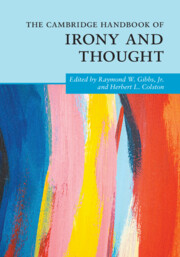Book contents
- The Cambridge Handbook of Irony and Thought
- Cambridge Handbooks in Psychology
- The Cambridge Handbook of Irony and Thought
- Copyright page
- Contents
- Contributors
- Part I Introduction
- Part II The Scope of Irony
- Part III Irony’s Impact
- Part IV Irony in Linguistic Communication
- Part V Irony, Affect, and Related Figures
- Part VI Irony in Expressive, Nonlinguistic Media
- 20 Ironies in Film
- 21 An Ear for Irony
- 22 Pictorial Irony and Sarcasm
- Index
- References
22 - Pictorial Irony and Sarcasm
from Part VI - Irony in Expressive, Nonlinguistic Media
Published online by Cambridge University Press: 20 December 2023
- The Cambridge Handbook of Irony and Thought
- Cambridge Handbooks in Psychology
- The Cambridge Handbook of Irony and Thought
- Copyright page
- Contents
- Contributors
- Part I Introduction
- Part II The Scope of Irony
- Part III Irony’s Impact
- Part IV Irony in Linguistic Communication
- Part V Irony, Affect, and Related Figures
- Part VI Irony in Expressive, Nonlinguistic Media
- 20 Ironies in Film
- 21 An Ear for Irony
- 22 Pictorial Irony and Sarcasm
- Index
- References
Summary
Pictorial irony is another example of nonverbal irony. This chapter addresses the need for experimental work on these topics in light of the view that irony is deeply tied to human cognition and not just language. Katz examines different ways of distinguishing between irony and sarcasm, particularly in terms of “vector space theory,” which suggests that sarcasm is more aggressive, dark, and mocking than is irony. Additional empirical analyses note important distinctions in defining the notions of verbal vs. situational irony. Katz then applies his “constraint-satisfaction” model to create an open-ended list of visual features that likely signal the presence of irony or sarcasm in visual, including pictorial, displays. Katz argues that basic psychological processes involved in scene perception, which have deep evolutionary roots, are employed when people infer either sarcastic or ironic intents in pictures (including pictures with and without accompanying words). At the same time, similar psychological processes used in detecting pretense or echoic mention within language can also be adopted for understanding visual scenes as conveying sarcasm or irony. Expertise with some visual medium, such as painting, may enhance people’s abilities to readily interpret these as expressing irony in different ways.
Keywords
- Type
- Chapter
- Information
- The Cambridge Handbook of Irony and Thought , pp. 402 - 425Publisher: Cambridge University PressPrint publication year: 2023
References
- 1
- Cited by



